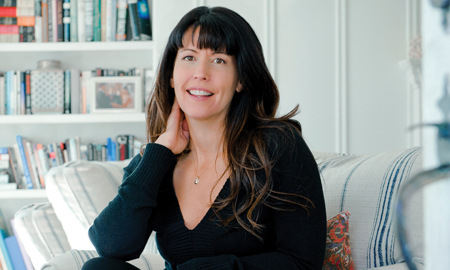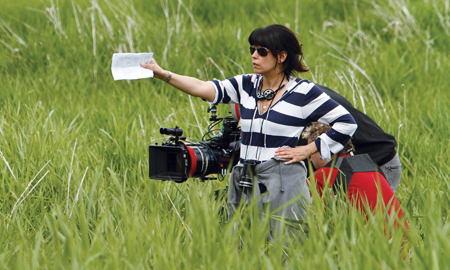By Lisa Rosen
 Jenkins wanted a lush, cinematic look and an emotional feel for the pilot of the murder investigation series The Killing.
Jenkins wanted a lush, cinematic look and an emotional feel for the pilot of the murder investigation series The Killing.
(Photo: Barry J Holmes) Patty Jenkins directs what she loves. She just happens to love vicious true crime drama and sparkling comedy though not at the same time, of course. Plumbing the most brutal depths of the human psyche inÊthe feature Monster and the AMC cable series The Killing comes to her as naturally as working out a joke on the quirky Arrested Development.
That dichotomy started early. Growing up on military bases all over the globe, Jenkins became a fan of clever British sitcoms. At the same time, she discovered the dramatic work of directors like Martin Scorsese, Elia Kazan, and Stanley Kubrick. “Those guys are great at the tension of the unknown,” she says. “You don’t know where the story is going, and you’re not made to feel comfortable or safe.”
After her family settled in Kansas, Jenkins became immersed in the arts, studying music and photography in high school, and attending Cooper Union for painting. That lasted until her first experimental filmmaking class. “They had a Steenbeck editing bay, and the first generation of video editing [equipment], the Toaster,” she recalls. She sat there day in, day out, putting music to image, never wanting to stop. “It was the first time I had a completely truthful relationship to art. I wanted to live up to the music that I heard, and make incredibly powerful emotional moments. That has continued to this day.”
Her painterly focus on craft led her to work on commercials as a cameraperson, so she could train on the job. “That was kind of misguided ultimately,” she notes. While she became skilled with all the equipment, she didn’t learn how to direct. So after eight years, she quit a successful career to attend AFI for directing.
Upon graduation, she met Brad Wyman, an indie producer who had made some low-budget serial killer movies. Jenkins, the true crime aficionado, told him he should make a film about Aileen Wuornos, a prostitute in Florida who had admitted to killing seven men. Jenkins was always bothered by the way Wuornos’ story had been sensationalized. “Brad said, ‘You should write it. You won’t get anything else made [as a first-timer],’” Jenkins says with a laugh. Thus, Monster was born.
While working on the script, she wrote to Wuornos, but the death row inmate was, unsurprisingly, mistrustful. Then, the night before her execution, Wuornos relented and left Jenkins all of her personal letters to review. With that shocking windfall, Jenkins knew she had to be the person to direct it. “There was no negotiation, it was going to be me or no one. I had been given the responsibility to see it through, and that’s what was going to have to happen.”
 Jenkins on the location for The Killing. (Photo by: Chris Large)
Jenkins on the location for The Killing. (Photo by: Chris Large) The miniscule $1.5 million budget and straight-to-video expectations actually helped give Jenkins the confidence to handle her first feature. With a 23-day shoot, she had no time for misgivings. “If I had my druthers, I would have shot that film with big wides, and scene-long single takes,” she says. But she had neither the time nor the money to spend on lighting and blocking such laborious shots. “Performance was so important that I needed to be able to cut every single take to get what I needed out of it. As a result, you have to compromise the style.” It turned out to be a wise choice: Charlize Theron won an Academy Award for her stunning portrayal of Wuornos. Jenkins garnered her share of accolades as well, including the Independent Spirit Award for Best First Feature.
After tackling such a serious subject, she was in a more playful mood. “Making a movie is such a huge commitment of emotion and time that I didn’t want to be beholden to doing it for money,” she says. At the same time, she wanted to keep working. She directed an episode of the ensemble comedy (and her favorite show) Arrested Development. “If you love the show and respect the people involved, living up to somebody else’s vision is a great learning ground.” Working with the show’s eccentric tone, she figured out how to time a joke, where to put the camera, and how to work with the actors; “it was completely fascinating new stuff.” So was working on Entourage, where she discovered how to shoot a car chase in a Maserati. Directing the boy’s club show was some of the most fun she’s had on the job, “with no emotional toll,” a relief after Monster.
After taking a year off for the birth of her son, Jenkins found it harder than expected to return to dramatic territory. She worked on a ghost story series for AMC that didn’t get picked up, but when the cable channel needed a director for the pilot of The Killing, they offered her the job. She almost turned them down. The drama was centered on the murder of a teenage girl. As a new mother, she found she could no longer watch crime stories about children, let alone direct them. Veena Sud, showrunner of The Killing, and also a mother, convinced her to take it on. “It’s like The Unforgiven of crime shows,” Jenkins explains. Rather than pop exploitation, “it was about focusing on the cost of a crime like that.”
In a neat circularity, the show gave her the opportunity to do some of the stylistic work she couldn’t do on Monster. “I had more time and money on that pilot than the film,” says Jenkins. Also, she finally got to do her big wides and single takes; all part of her Killing repertoire. “I wanted a lush cinematic look, and an emotional feel, to juxtapose against the story and expectations of the genre.” Hence, all the rain. She found “the tension of the unknown” she admired in her favorite movies was easy to achieve on the pilot because “episodic drama is all about withholding.”
The pilot earned Jenkins the 2011 DGA Award for Outstanding Directorial Achievement in Dramatic Series. Then to finish what she started, she directed the show’s season two finale, in which the killer was finally revealed.
Now working on a true crime feature script that she plans to direct (but is too early to talk about), she says TV has helped her craft evolve. “I really understand visuals in a way that I didn’t before, which is by no means to say I’m a master at all,” she admits. “It’s only to say that by getting to try out a bunch of different styles, and different lenses, my understanding has become more fluid.” Earlier in her career, every decision required intense thought and doubt. These days it comes as easily to her as switching genres. “It’s much more fun now.”